20 Common Types of Sparrows in Alabama (With Pictures)
Last Updated on
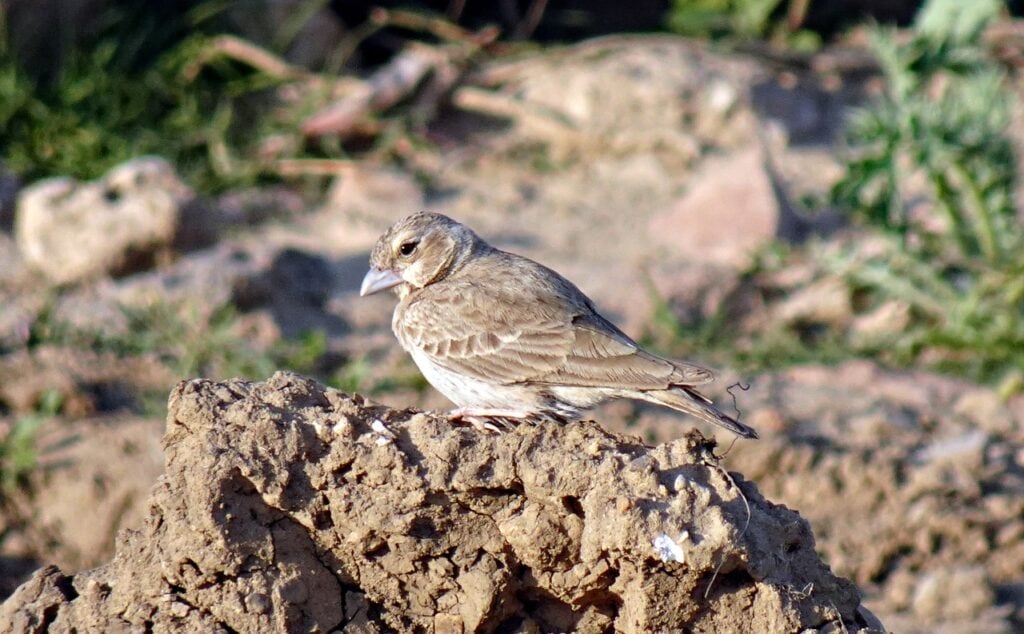
Did you know that Alabama ranks 4th in terms of biodiversity among all 50 states in the US? It’s also 1st among states east of the Mississippi River. There are 420 bird species that call Alabama home during at least part of the year. That includes around 20 species of sparrows.
Sparrows are energetic little birds that can bless you with their song, and you may also find them nesting near and around your home and backyard. Let’s learn more about the different species of these little brown birds in the sparrow family, which also includes juncos and towhees, that you may see in Alabama.

The 20 Common Types of Sparrows in Alabama
1. Bachman’s Sparrow (Peucaea aestivalis)
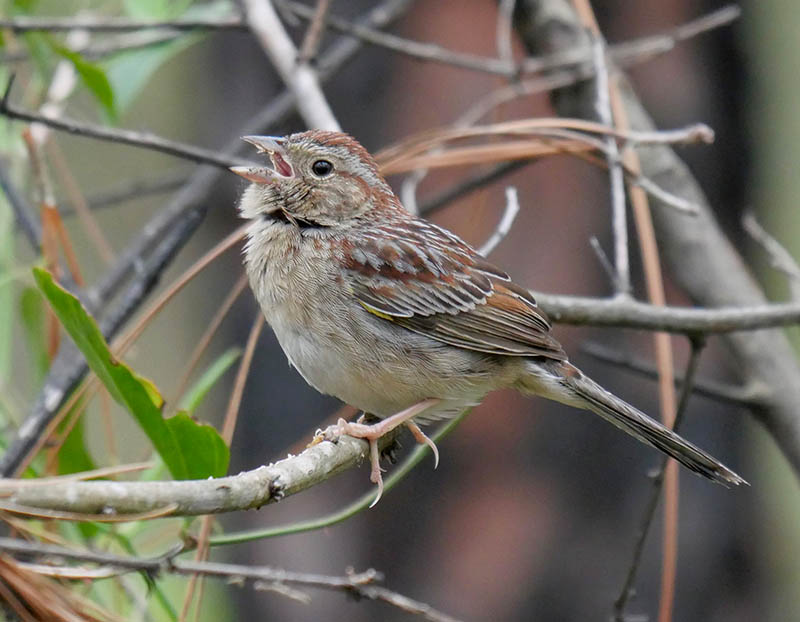
| Scientific Name: | Peucaea aestivalis |
| Height: | 9-6.0 in. |
| Weight: | 6-0.8 oz. |
| Wingspan: | 2 in. |
Bachman’s Sparrow is not the most common type of sparrow that you will see in Alabama but they do live in the state as well as other states in the southeast US only. However, they can be found throughout central and southern Alabama during the non-breeding season and move into north Alabama during the breeding season. These birds primarily live in grassy pine forests and can be quite secretive, so spotting one is rare. These sparrows are brownish gray, with a rust-colored head and wings. They mostly feed on seeds. Bachman’s Sparrows are on the conservation Watch List.
2. Chipping Sparrow ( Spizella passerina)
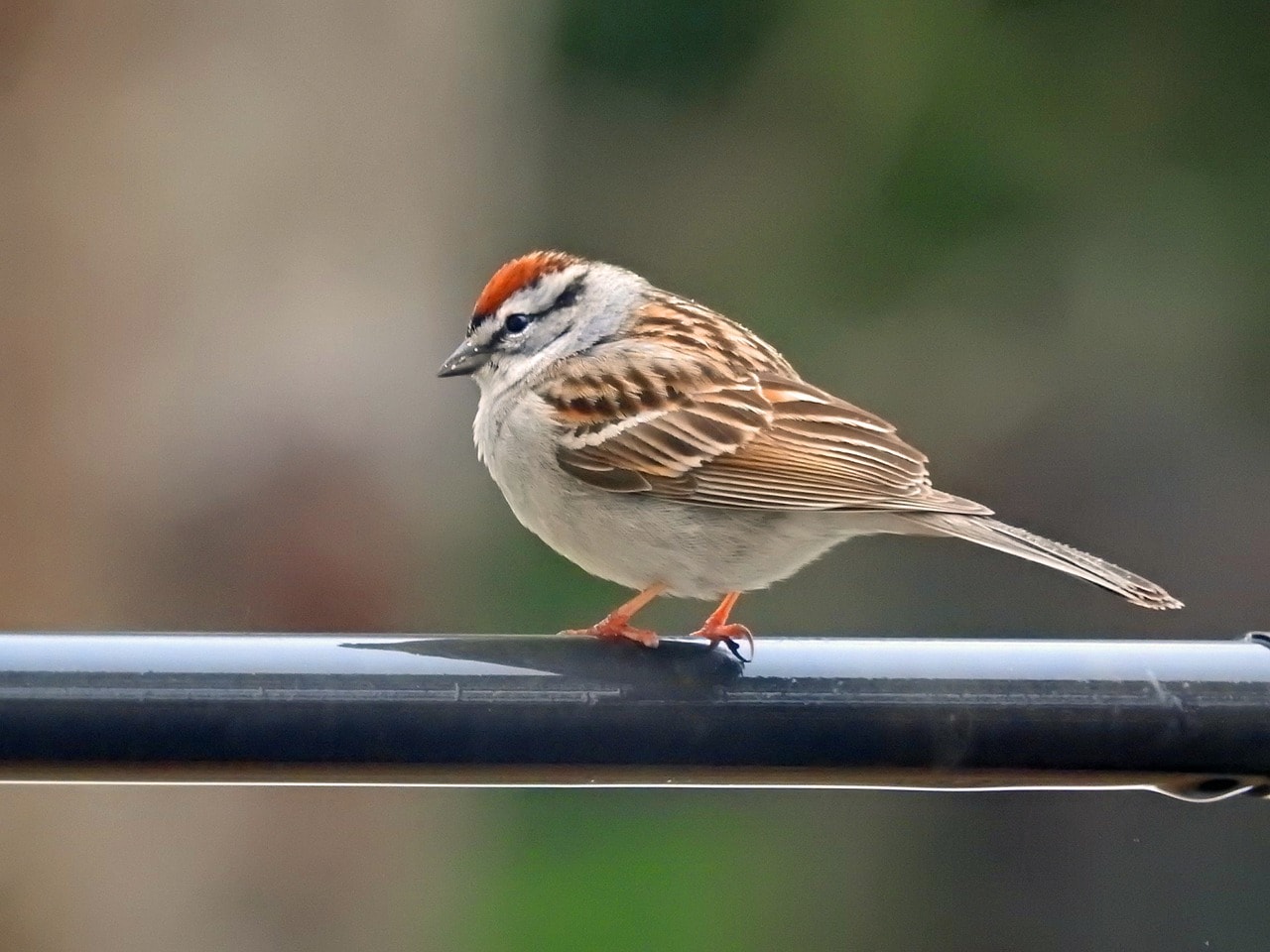
| Scientific Name: | Spizella passerina |
| Height: | 7-5.9 in. |
| Weight: | 4-0.6 oz. |
| Wingspan: | 3 in. |
The Chipping Sparrow is one of the most common types of sparrows you’ll see in Alabama during the breeding season. They’re one of the most common sparrows in the US as a whole. Chipping Sparrows are easy to identify with their white chests and stomachs, tan and brown striped wings, and reddish-orange caps. These plump little birds are easy to spot in open woodlands, often nesting in shrubs and foraging for seeds. Their conservation status is of low concern.
3. Dark-eyed Junco (Junco hyemalis)
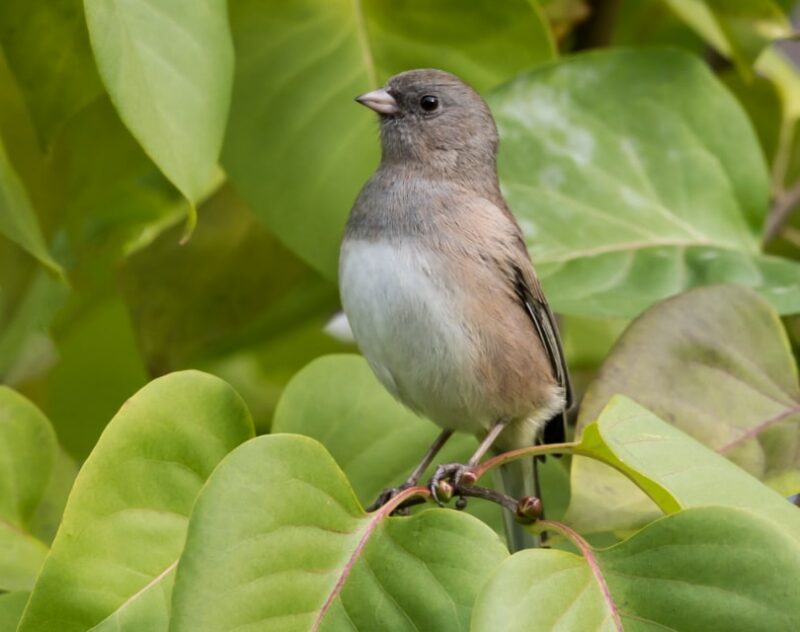
| Scientific Name: | Junco hyemalis |
| Height: | 5-6.3 in. |
| Weight: | 6-1.1 oz. |
| Wingspan: | 1-9.8 in. |
Although they aren’t called “sparrows,” Dark-eyed Juncos are part of the sparrow family. The plump little birds can be found throughout the state of Alabama during the fall and winter, which is the non-breeding season. Dark-eyed Juncos can be recognized by their white bellies and dark gray chest, head, and wings. They typically live in forests and forage for seeds, but will also visit backyard bird feeders. Their conservation status is listed as being of low concern.
4. Eastern Towhee (Pipilo erythrophthalmus)
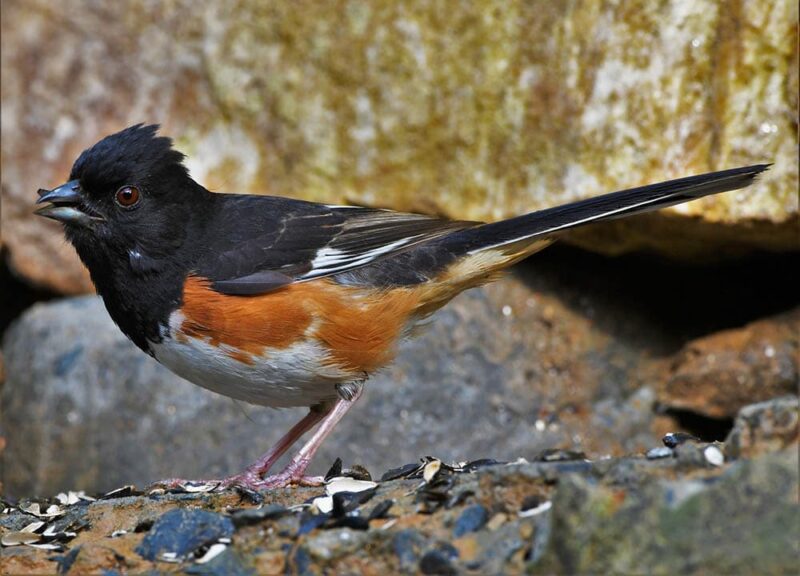
| Scientific Name: | Pipilo erythrophthalmus |
| Height: | 8-8.2 in. |
| Weight: | 1-1.8 oz. |
| Wingspan: | 9-11.0 in. |
Eastern Towhees are another member of the sparrow family and are actually one of the largest sparrow species. They can be found in Alabama year-round. Eastern Towhees are very striking in their appearance and can be easily recognized as a result. They have a black head, chest, and wings, white stomach, and orange sides. They tend to inhabit bushy areas and have a distinctive call that sounds like chewink. Eastern Towhees are omnivores, eating mostly seeds and insects. They are of low conservation concern.
5. Field Sparrow (Spizella pusilla)

| Scientific Name: | Spizella pusilla |
| Height: | 7-5.9 in. |
| Weight: | 4-0.5 oz. |
| Wingspan: | 9 in. |
Field Sparrows are another very common and easily spotted sparrow species in Alabama due to the fact that they inhabit the state year-round. You can easily recognize their trill song during the summer months, especially if you live near an area with open and brushy fields as this is where this sparrow typically lives. Their coloring is lighter than other sparrows, with a tan or cream colored stomach and chest with warm brown tones on their wings and rusty cap on their head. They feed mostly on insects and although they are a common bird, the population of field sparrows is in steep decline.
6. Fox Sparrow (Passerella iliaca)

| Scientific Name: | Passerella iliaca |
| Height: | 9-7.5 in. |
| Weight: | 9-1.6 oz. |
| Wingspan: | 5-11.4 in. |
Fox Sparrows can be found in Alabama during the non-breeding season. They fly south during the winter for the warmer temperatures than what would be found in their spring and summer home of Alaska and Canada. Fox Sparrows have a brown or reddish-brown coloring on their wings with brown and white splotches on their chest and stomach and a gray patch on the head and back of the neck. They live in forests and can be commonly seen foraging for their primary food, insects, in leaf litter. You may even see one in your backyard if you live in a remote area with lots of trees. They are of low conservation concern.
7. Grasshopper Sparrow (Ammodramus savannarum)
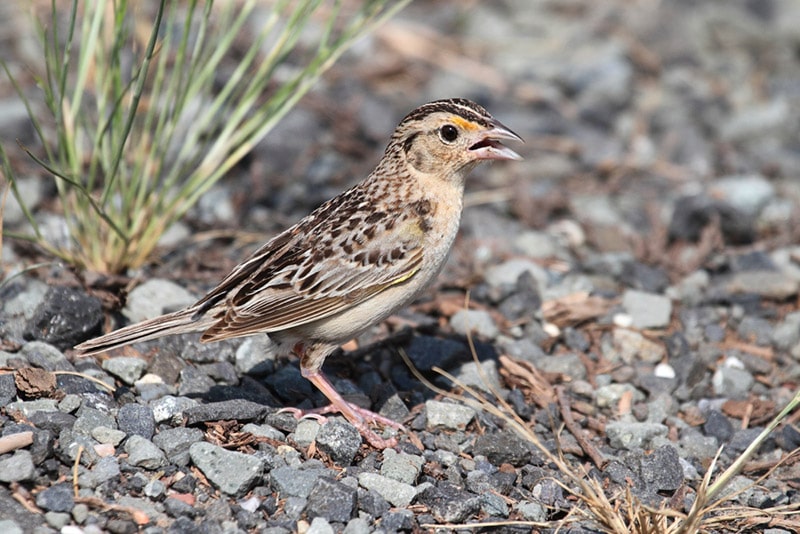
| Scientific Name: | Ammodramus savannarum |
| Height: | 3-4.5 in. |
| Weight: | 5-0.7 oz. |
| Wingspan: | 9 in. |
Grasshopper Sparrows can be found in north Alabama year-round, but move into more central and southern parts of Alabama during the non-breeding season. Their song sounds almost insect-like, like the sound a grasshopper makes, hence the name. Grasshopper sparrows have a buffy tan chest and stomach, with brown and tan streaked wings, along with small light orange patches on parts of their body. They also have a larger beak than most sparrows. Grasshopper Sparrows live in grassland habitats where they run through the grass looking for insects to eat. They are a common bird but their population is in a steep decline.
8. Henslow’s Sparrow (Centronyx henslowii)

| Scientific Name: | Centronyx henslowii |
| Height: | 3-5.1 in. |
| Weight: | 4-0.5 oz. |
| Wingspan: | 3-7.9 in. |
Henslow’s Sparrows are found only in south Alabama during the non-breeding season. Unlike other sparrow species, Henslow’s sparrows aren’t really songbirds and they are one of the smallest sparrow species as well. These two characteristics make them quite easy to miss. They do have a unique, almost tiger-like appearance though, with cream/yellow/tan coloring and black stripes on their heads, necks, and wings. Henslow’s Sparrows live primarily in grassland habitats and feed on insects. The population of Henslow’s Sparrows is declining.
9. House Sparrow (Passer domesticus)
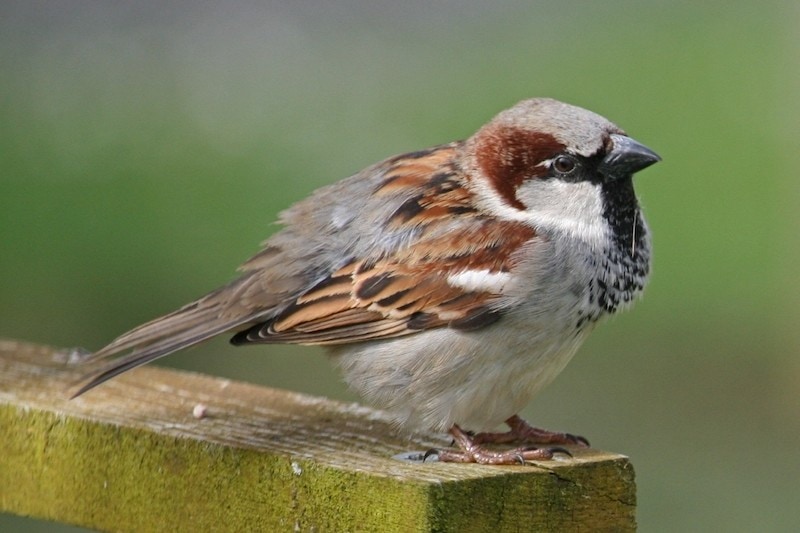
| Scientific Name: | Passer domesticus |
| Height: | 9-6.7 in. |
| Weight: | 9-1.1 oz. |
| Wingspan: | 5-9.8 in. |
House Sparrows are found in Alabama, as well as the rest of the United States, year-round. Unlike other sparrows that live in forests and grassland habitats, House Sparrows live in towns and developed areas. This is the type of sparrow you’ll usually find creating nests in nooks and crannies around your home, as they are cavity nesters. Some people even find them a nuisance because of their tendency to always be there, sometimes even running other birds out of birdhouses and nesting boxes. House Sparrows have a striking white belly and chest with a dark brown head. Their wings are dark brown and black. House Sparrows are omnivores, eating mostly seeds and insects. They’ll commonly visit backyard bird feeders since they live close to houses anyway. These birds are quite common with a low conservation concern.
10. Lark Sparrow (Chondestes grammacus)

| Scientific Name: | Chondestes grammacus |
| Height: | 9-6.7 in. |
| Weight: | 8-1.2 oz. |
| Wingspan: | 0 in. |
Lark Sparrows can only be found in the far north and northwest corner of Alabama, and only during the summer months, or breeding season. They are called Lark Sparrows because their call sounds similar to a lark, so it can be hard to distinguish between the two birds based on the call alone. Lark Sparrows have white chest and stomach, tan wings with dark brown stripes, and a rusty brown head with white and black streaks. Lark Sparrows tend to hop and crouch during courtship, which is unique from other sparrows. They live in grasslands, forage for seeds, and are of low conservation concern.
11. LeConte’s Sparrow (Ammospiza leconteii)
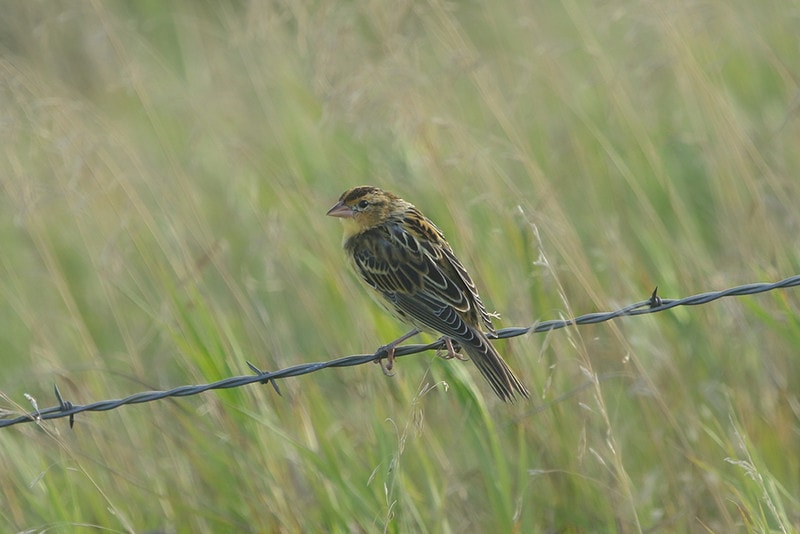
| Scientific Name: | Ammospiza leconteii |
| Height: | 7-5.1 in. |
| Weight: | 4-0.6 oz. |
| Wingspan: | 3-7.1 in. |
Leconte’s Sparrow isn’t typically found in Alabama except during the non-breeding season. And even then, you’ll only see them if you live along the border of Alabama and Mississippi or in the two southernmost counties of Alabama that are along the coast of the Gulf of Mexico. These sparrows are known for being stealthy and elusive, so spotting one is rare. Most of this sparrow’s body is light orange colored, with a white stomach and dark brown to almost black (and some white coloring) on its wings. Leconte’s Sparrows live in grasslands and feed on insects. Their population is declining.
12. Lincoln’s Sparrow (Melospiza lincolnii)
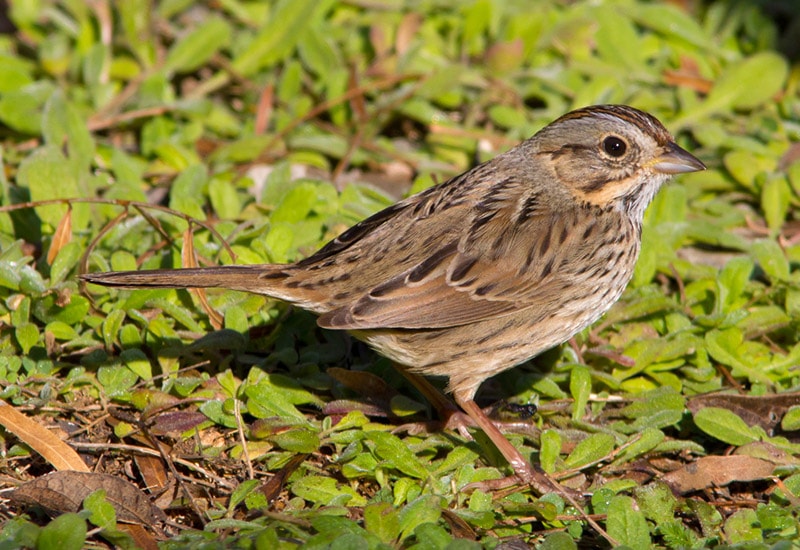
| Scientific Name: | Melospiza lincolnii |
| Height: | 1-5.9 in. |
| Weight: | 6-0.7 oz. |
| Wingspan: | 5-8.7 in. |
Lincoln’s Sparrow can be found throughout most of Alabama only during their migration down to Mexico for the non-breeding season. They are hot to spot because they tend to stay low to the ground under the cover of bushes and shrubs. Lincoln’s Sparrows have a white belly, but are tan to light brown on the rest of their bodies, with darker brown flecks of color throughout. Their call is similar to a House Wren. They live in bushy areas, forage for insects, and are of low conservation concern.
13. Nelson’s Sparrow (Ammospiza nelsoni)
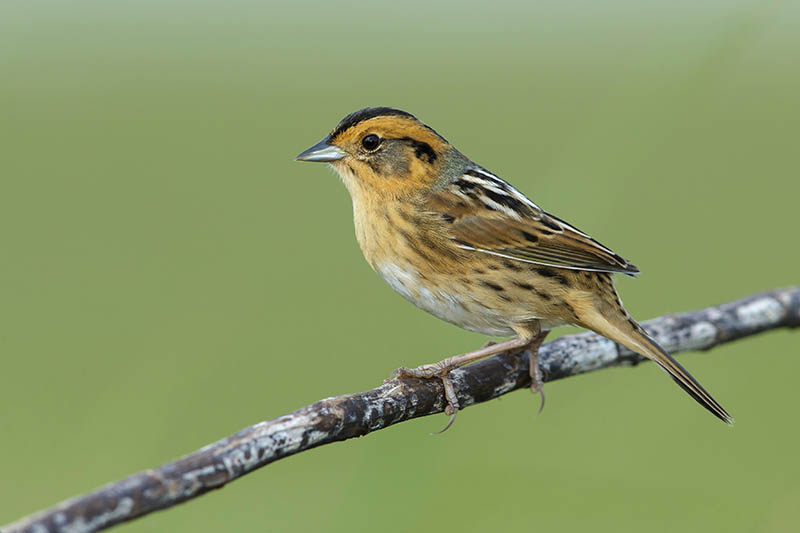
| Scientific Name: | Ammospiza nelsoni |
| Height: | 3-5.1 in. |
| Weight: | 6-0.7 oz. |
| Wingspan: | 5-7.9 in. |
Nelson’s Sparrow lives in marshy areas of coastal Alabama during the non-breeding season. These birds have a shorter tail than other sparrow species. They have a saffron yellow head and neck with gray cheeks, a white stomach, saffron yellow sides, and brown wings, making them stand out from other sparrow species. Nelson’s Sparrows forage for insects that live in the marsh and their population is of low concern.
14. Savannah Sparrow (Passerculus sandwichensis)
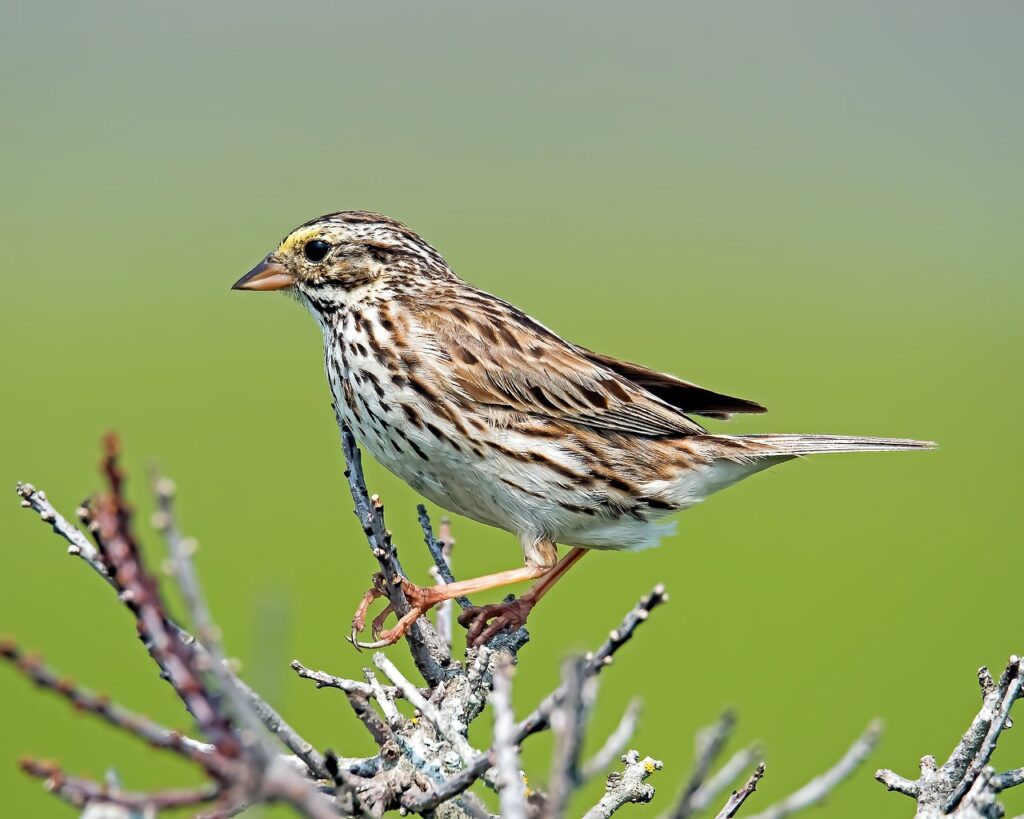
| Scientific Name: | Passerculus sandwichensis |
| Height: | 3-5.9 in. |
| Weight: | 5-1.0 oz. |
| Wingspan: | 9-8.7 in. |
The Savannah Sparrow is found throughout Alabama during the non-breeding season. These sparrows are actually very numerous but may get misidentified due to their similar appearance to other songbirds. However, they can be distinguished by the yellow streak above each eye. They also have a white a brown flecked chest and light and dark brown striped wings. They live in grasslands and forage for insects. Because they are so numerous, they are of low conservation concern.
15. Seaside Sparrow (Ammospiza maritima)

| Scientific Name: | Ammospiza maritima |
| Height: | 1-5.9 in. |
| Weight: | 7-1.0 oz. |
| Wingspan: | 1-7.9 in. |
The Seaside Sparrow lives in Alabama year-round, but only along the coast, hence the name. Seaside Sparrows are darker than other sparrows. They have a mostly gray and tan coloring, with white flecks on their chest and yellow streaks running from the beak to around the top of the eye. They also have a larger and very strong beak, along with strong legs for digging in mud for insects in the thick vegetation of marshy areas where they live. They are on the conservation Watch List due to their restricted range along the Gulf and east coast of the United States.
16. Song Sparrow (Melospiza melodia)
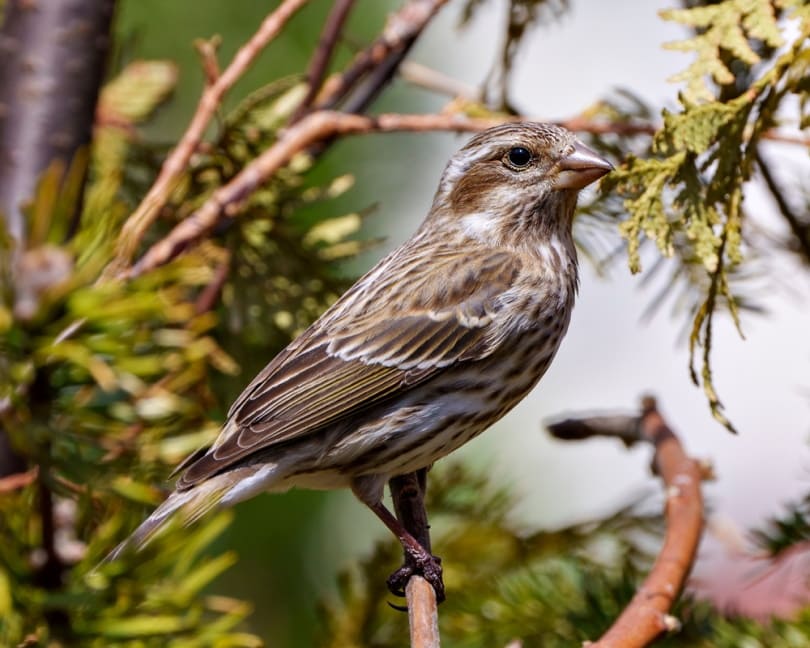
| Scientific Name: | Melospiza melodia |
| Height: | 7-6.7 in. |
| Weight: | 4-1.9 oz. |
| Wingspan: | 1-9.4 in. |
Song Sparrows live in Alabama during the non-breeding season but they can be found throughout the United States as well as may differ slightly in appearance based on where they live. However, all Song Sparrows have a white chest with russet brown streaks, and a tan or gray back with russet brown streaks on their wings. Its trill song is easily recognizable. Song Sparrows usually live in open woodlands and nest in shrubs. They feed mostly on insects and population numbers are stable, making them of low conservation concern.
17. Swamp Sparrow (Melospiza georgiana)
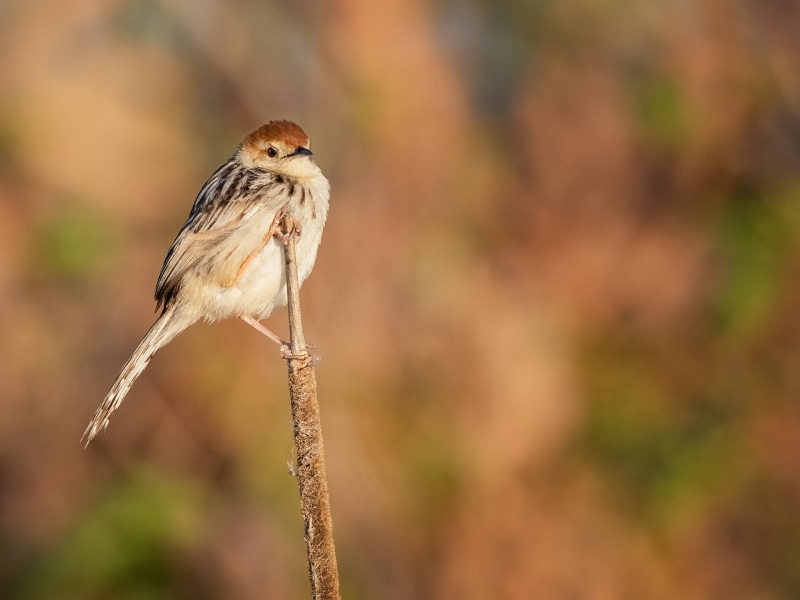
| Scientific Name: | Melospiza georgiana |
| Height: | 7-5.9 in. |
| Weight: | 5-0.8 oz. |
| Wingspan: | 1-7.5 in. |
Swamp Sparrows live in wetlands and marshy areas throughout the entire state of Alabama during the non-breeding season. They are common birds, but can be hard to spot since they like to hide among cattails and other aquatic plants. They have a rust-colored cap and wings with gray, tan, buff, brown, and cream colors on the rest of the body. This coloring allows them to blend in easily. These birds nest in shrubs and feed on insects. The Swamp Sparrow is of low conservation concern.
18. Vesper Sparrow (Pooecetes gramineus)

| Scientific Name: | Pooecetes gramineus |
| Height: | 1-6.3 in. |
| Weight: | 7-1.0 oz. |
| Wingspan: | 4 in. |
Vesper Sparrows inhabit Alabama during the non-breeding season. These sparrows are quite unique in appearance, having a body that is mostly white with brown flecks on the body and brown stripes on the wings. They also have a chestnut brown patch on each shoulder. Their coloring helps them blend into their surroundings during the fall and winter months. Vesper Sparrows live in grasslands and feed on insects. Despite being hard to spot, they are common sparrows with a low conservation concern.
19. White-crowned Sparrow (Zonotrichia leucophrys)
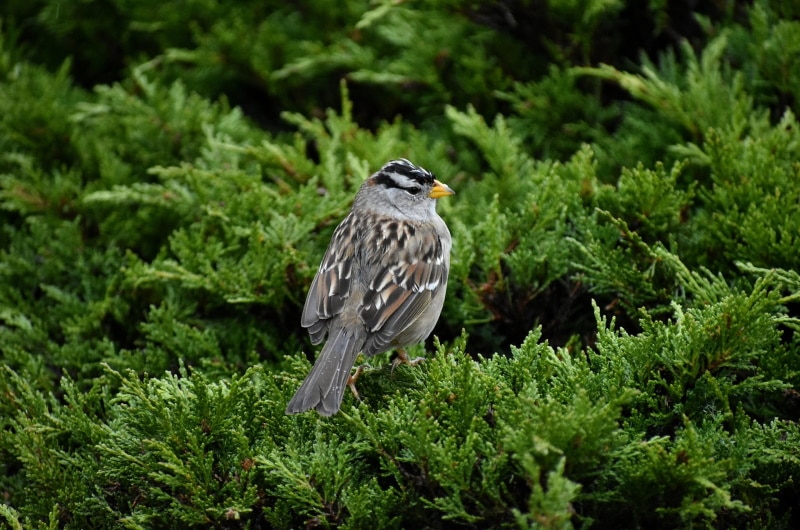
| Scientific Name: | Zonotrichia leucophrys |
| Height: | 9-6.3 in. |
| Weight: | 9-1.0 oz. |
| Wingspan: | 3-9.4 in. |
Like many other sparrows on this list, White-crowned Sparrows are only found in Alabama during the non-breeding season. They are easy to recognize due to their black and white head, gray neck and chest, light brown sides and back, and beautiful dark brown and white streaked wings. It’s actually quite hard to misidentify the White-crown Sparrow. These birds live in brushy areas and eat mostly insects, but will visit backyard bird feeders as well. They are of low conservation concern.
20. White-throated Sparrow (Zonotrichia albicollis)
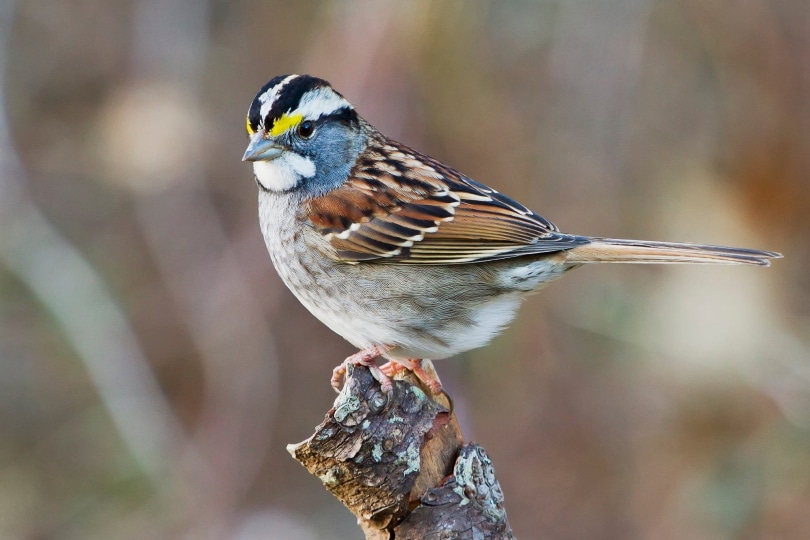
| Scientific Name: | Zonotrichia albicollis |
| Height: | 3-7.1 in. |
| Weight: | 8-1.1 oz. |
| Wingspan: | 9-9.1 in. |
The White-throated Sparrow is the final species of sparrow that can commonly be found in Alabama. This sparrow can be found throughout the state during the non-breeding season. It’s another sparrow species that is easy to identify. White-throated Sparrows have a white throat, as the name implies. They also have a black stripe running down the middle of their head with a bright yellow patch on each side above the eye. Behind the eye is white, with gray cheeks and chest, a white stomach, and light and dark brown streaked wings with white wing tips. These sparrows live in forests, eat mostly seeds, and are of low conservation concern.

Conclusion
So there you have it, 20 common types of sparrows found in Alabama. There may be a few more sparrow species that are found throughout the state sporadically, but these are the ones that are the most numerous and live in the state for the longest time during the year. Most of these sparrows are quite numerous and live in forests, open areas, or maybe even around your home and backyard. Hopefully, this guide enables you to identify any sparrow species that you may come across in the state.
See also: 11 Common Types of Sparrows in Ohio (With Pictures)
Featured Image Credit: sarangib, Pixabay
Table of Contents
- The 20 Common Types of Sparrows in Alabama
- 1. Bachman’s Sparrow (Peucaea aestivalis)
- 2. Chipping Sparrow ( Spizella passerina)
- 3. Dark-eyed Junco (Junco hyemalis)
- 4. Eastern Towhee (Pipilo erythrophthalmus)
- 5. Field Sparrow (Spizella pusilla)
- 6. Fox Sparrow (Passerella iliaca)
- 7. Grasshopper Sparrow (Ammodramus savannarum)
- 8. Henslow’s Sparrow (Centronyx henslowii)
- 9. House Sparrow (Passer domesticus)
- 10. Lark Sparrow (Chondestes grammacus)
- 11. LeConte’s Sparrow (Ammospiza leconteii)
- 12. Lincoln’s Sparrow (Melospiza lincolnii)
- 13. Nelson’s Sparrow (Ammospiza nelsoni)
- 14. Savannah Sparrow (Passerculus sandwichensis)
- 15. Seaside Sparrow (Ammospiza maritima)
- 16. Song Sparrow (Melospiza melodia)
- 17. Swamp Sparrow (Melospiza georgiana)
- 18. Vesper Sparrow (Pooecetes gramineus)
- 19. White-crowned Sparrow (Zonotrichia leucophrys)
- 20. White-throated Sparrow (Zonotrichia albicollis)
- Conclusion
About the Author Savanna Stanfield
Savanna is a former science teacher who is now a full-time freelance writer currently living in the United States with her husband and daughter. Other members of her family include a long-haired chihuahua named Penny, three cats, and an aquatic turtle named Creek. In addition to writing, her passions include gardening, traveling, and protecting our wildlife and natural resources.
Related Articles:
Monocular vs Telescope: Differences Explained (With Pictures)
10 Types of Hummingbirds in Arkansas (With Pictures)
8 Types of Hummingbirds in Nebraska (With Pictures)
5 Types of Hummingbirds in Idaho (With Pictures)
3 Types of Hummingbirds in Mississippi (With Pictures)
8 Types of Hummingbirds in Kansas (With Pictures)
5 Types of Hummingbirds in West Virginia (With Pictures)
5 Types of Hummingbirds in Ohio (With Pictures)
